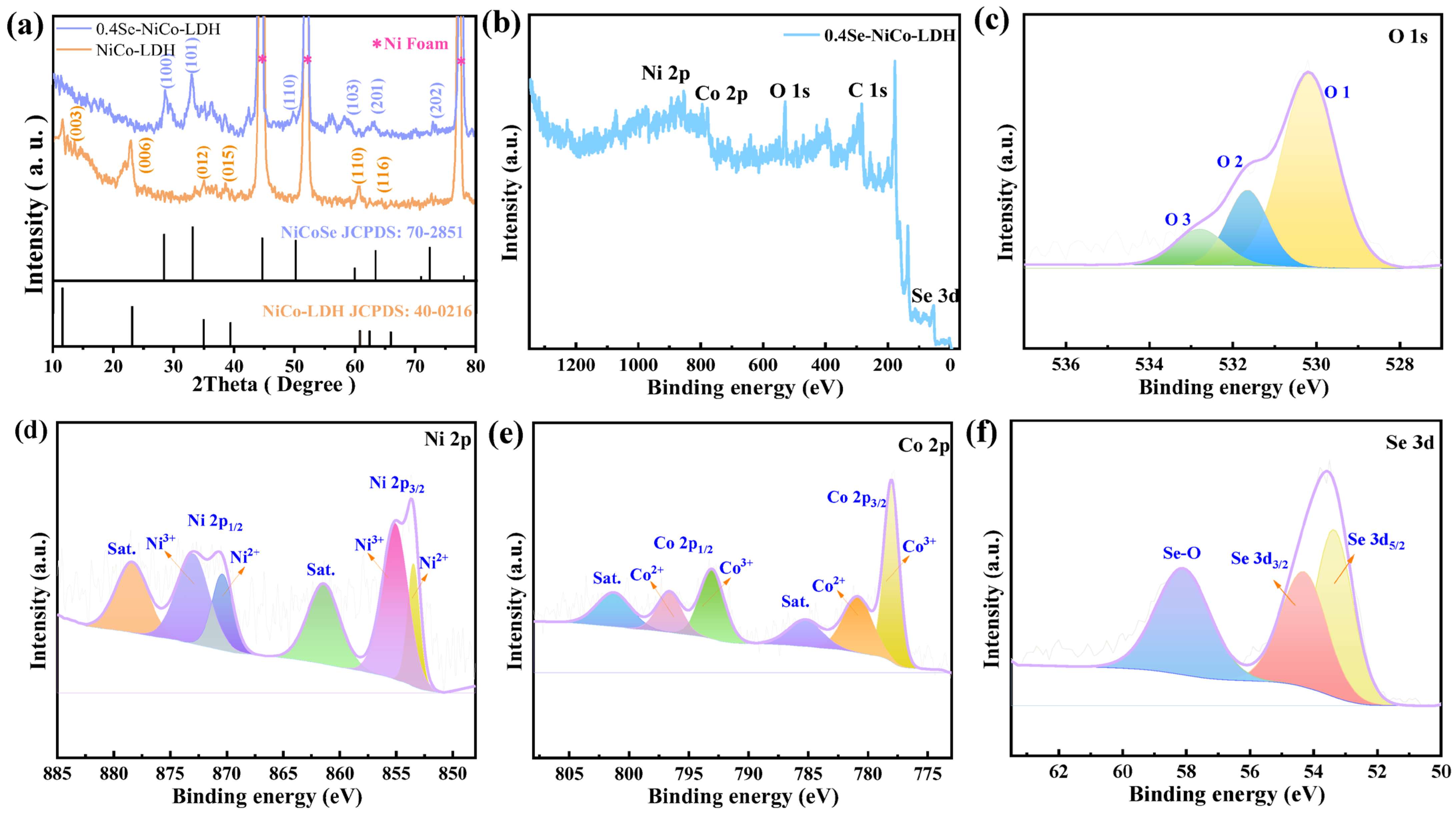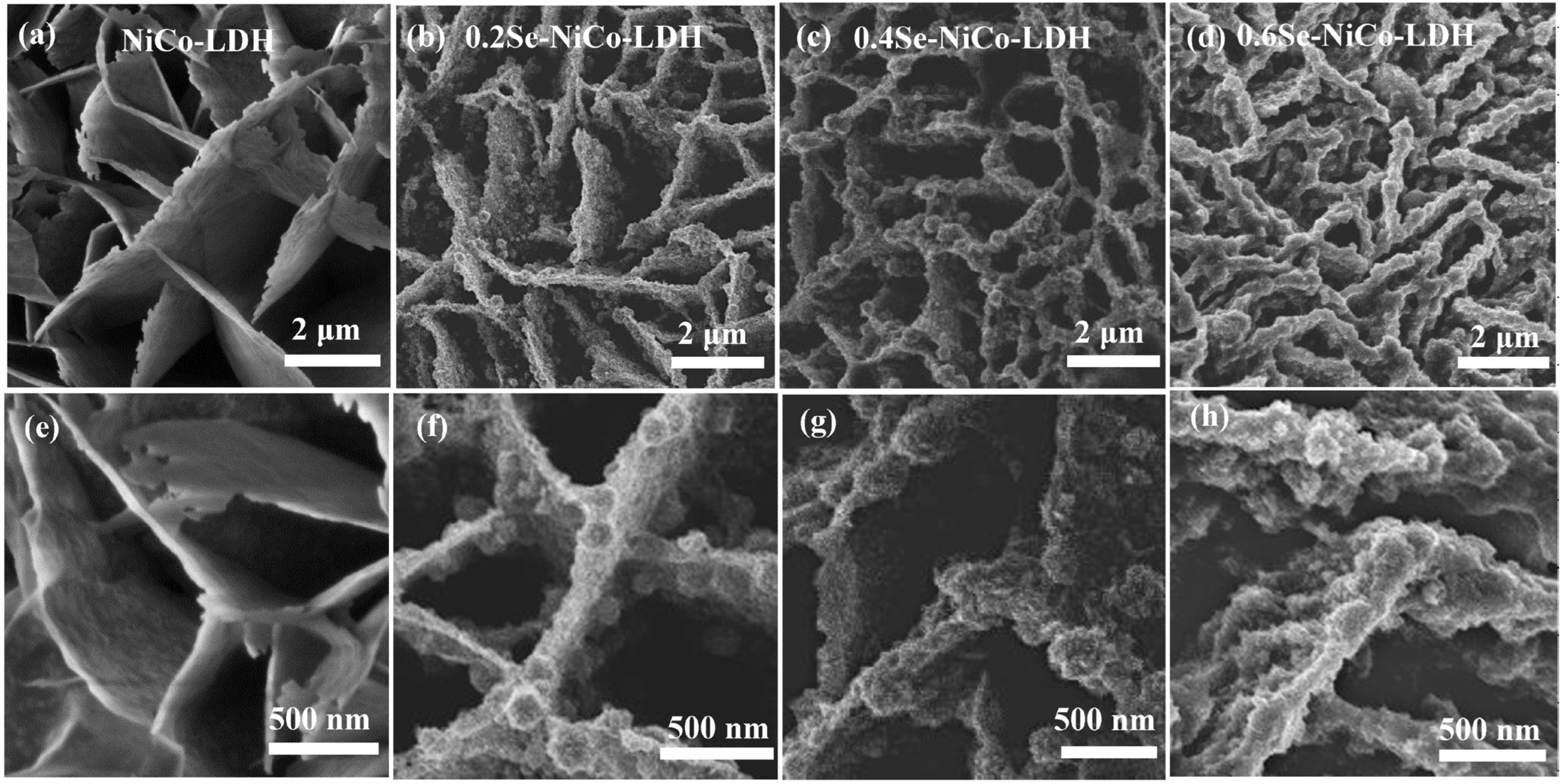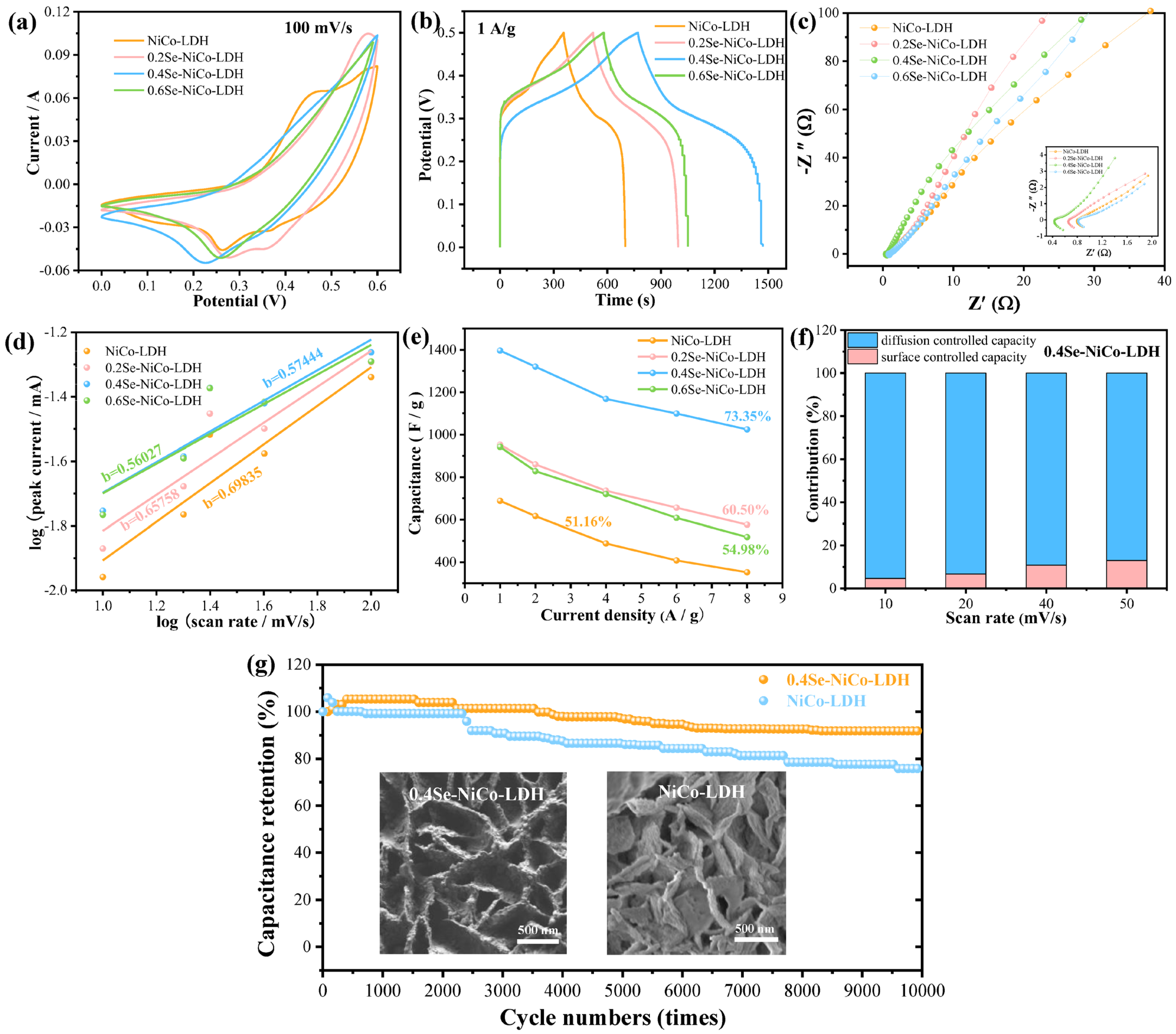Surface Selenization of NiCo-Layered Double Hydroxide Nanosheets for High-Performance Supercapacitors
Abstract
1. Introduction
2. Materials and Methods
3. Results and Discussion
4. Conclusions
Author Contributions
Funding
Conflicts of Interest
References
- Liu, Y.; Liu, Y.; Wu, X.; Cho, Y.R. Enhanced electrochemical performance of Zn/VOx batteries by a carbon encapsulation strategy. ACS Appl. Mater. Interfaces 2022, 14, 11654–11662. [Google Scholar]
- Liu, Y.; Wu, X. Hydrogen and sodium ions cointercalated vanadium dioxide electrode materials with enhanced zinc ion storage capacity. Nano Energy 2021, 86, 106124. [Google Scholar] [CrossRef]
- Kamel, A.A.; Rezk, H.; Shehata, N.; Thomas, J. Energy management of a DC microgrid composed of photovoltaic/fuel cell/battery/supercapacitor systems. Batteries 2019, 5, 63. [Google Scholar] [CrossRef]
- Wang, M.D.; Liu, X.Y.; Sun, Y.C.; Wu, X. High-efficient NiCo layered double hydroxide electrocatalyst. New J. Chem. 2022, 46, 18535–18542. [Google Scholar] [CrossRef]
- Wang, S.; Ma, J.X.; Shi, X.Y.; Zhu, Y.Y.; Wu, Z.S. Recent status and future perspectives of ultracompact and customizable micro-supercapacitors. Nano Res. Energy 2022, 1, e9120018. [Google Scholar] [CrossRef]
- Rastabi, S.A.; Mamoory, R.S.; Blomquist, N.; Phadatare, M.; Olin, H. Synthesis of a NiMoO4/3D-rGO nanocomposite via starch medium precipitation method for supercapacitor performance. Batteries 2020, 6, 5. [Google Scholar] [CrossRef]
- Liu, X.Y.; Wang, M.D.; Wu, X. Tailoring Electrochemical Performance of Co3O4 Electrode Materials by Mn Doping. Molecules 2022, 27, 7344. [Google Scholar] [CrossRef]
- Gu, J.W.; Peng, Y.; Zhou, T.; Ma, J.; Pang, H.; Yamauchi, Y.S. Porphyrin-based framework materials for energy conversion. Nano Res. Energy 2022, 1, e9120009. [Google Scholar] [CrossRef]
- Liu, Y.; Hu, P.F.; Liu, H.Q.; Song, J.R.; Umar, A.; Wu, X. Toward high performance asymmetric hybrid capacitor by electrode optimization. Inorg. Chem. Front. 2019, 6, 2824–2831. [Google Scholar] [CrossRef]
- Sun, Y.C.; Wang, X.W.; Wu, X. High-performance flexible hybrid capacitors by regulating NiCoMoS@Mo0.75-LDH electrode structure. Mater. Res. Bull. 2023, 158, 112073. [Google Scholar] [CrossRef]
- Liang, J.; Liu, Q.; Alshehri, A.A.; Sun, X.P. Recent advances in nanostructured heterogeneous catalysts for N-cycle electrocatalysis. Nano Res. Energy 2022, 1, e9120010. [Google Scholar] [CrossRef]
- Liu, Y.; Zhao, D.P.; Liu, H.Q.; Umar, A.; Xiang, W. High performance hybrid supercapacitor based on hierarchical MoS2/Ni3S2 metal chalcogenide. Chin. Chem. Lett. 2019, 30, 1105–1110. [Google Scholar] [CrossRef]
- Song, F.; Hu, X. Exfoliation of layered double hydroxides for enhanced oxygen evolution catalysis. Nat. Commun. 2014, 5, 4477. [Google Scholar] [CrossRef]
- Jagadale, A.D.; Guan, G.Q.; Li, X.M.; Du, X.; Ma, X.L.; Hao, X.G.; Abudula, A. Ultrathin nanoflakes of cobalt-manganese layered double hydroxide with high reversibility for asymmetric supercapacitor. J. Power Sources 2016, 36, 526–534. [Google Scholar] [CrossRef]
- Ni, G.; Cheng, J.; Dai, X.; Guo, Z.H.; Ling, X.; Yu, T.; Sun, Z.J. Integrating ultrathin polypyrrole framework on nickel-cobalt layered double hydroxide as an amperometric sensor for nonenzymatic glucose determination. Electroanalysis 2018, 30, 2366–2373. [Google Scholar] [CrossRef]
- Wang, W.C.; Zhang, N.; Shi, Z.Y.; Ye, Z.R.; Gao, Q.Y.; Zhi, M.J.; Hong, Z.L. Preparation of Ni-Al layered double hydroxide hollow microspheres for supercapacitor electrode. Chem. Eng. J. 2018, 338, 55–61. [Google Scholar] [CrossRef]
- Lu, Y.; Jiang, B.; Fang, L.; Ling, F.L.; Wu, F.; Hu, B.S.; Meng, F.; Niu, K.Y.; Lin, F.; Zheng, H.M. An investigation of ultrathin nickel-iron layered double hydroxide nanosheets grown on nickel foam for high-performance supercapacitor electrodes. J. Alloys Compd. 2017, 714, 63–70. [Google Scholar] [CrossRef]
- Khalafallah, D.; Li, X.Y.; Zhi, M.J.; Hong, Z.L. Three-dimensional hierarchical NiCo layered double hydroxide nanosheet arrays decorated with noble metals nanoparticles for enhanced urea electrocatalysis. ChemElectroChem 2019, 7, 163–174. [Google Scholar] [CrossRef]
- Wang, M.D.; Liu, X.Y.; Liu, H.Q.; Zhao, D.P.; Wu, X. NiCo layered double hydroxide nanosheets with enhanced electrochemical performance. J. Alloys Compd. 2022, 903, 163926. [Google Scholar] [CrossRef]
- Li, X.Y.; Khalafallah, D.; Wu, Z.X.; Zhi, M.J.; Hong, Z.L. Silver incorporated partially reduced NiCo-layered double hydroxide frameworks for asymmetric supercapacitors. J. Energy Storage 2020, 31, 101578. [Google Scholar] [CrossRef]
- Wu, Z.X.; Khalafallah, D.; Teng, C.Q.; Wang, X.Q.; Zou, Q.; Chen, J.H.; Zhi, M.J.; Hong, Z.L. Vanadium doped hierarchical porous nickel-cobalt layered double hydroxides nanosheet arrays for high-performance supercapacitor. J. Alloys Compd. 2020, 838, 155604. [Google Scholar] [CrossRef]
- Zhang, K.L.; Li, Y.H.; Deng, S.J.; Shen, S.H.; Zhang, Y.; Pan, G.X.; Xiong, Q.Q.; Liu, Q.; Xia, X.H.; Wang, X.L.; et al. Molybdenum selenide electrocatalysts for electrochemical hydrogen evolution reaction. ChemElectroChem 2019, 6, 3530–3548. [Google Scholar] [CrossRef]
- Liu, Y.X.; Gong, J.X.; Wang, J.H.; Hu, C.H.; Xie, M.Z.; Jin, X.L.; Wang, S.; Dai, Y.T. Facile fabrication of MXene supported nickel-cobalt selenide ternary composite via one-step hydrothermal for high-performance asymmetric supercapacitors. J. Alloys Compd. 2022, 899, 163354. [Google Scholar] [CrossRef]
- Yang, Q.J.; Liu, Y.; Deng, C.Y.; Sun, L.; Shi, W.D. In-situ construction of heterostructure (Ni, Co)Se2 nanoarrays derived from cone-like ZIF-L for high performance hybrid supercapacitors. J. Colloid Interface Sci. 2022, 608, 3049–3058. [Google Scholar] [CrossRef] [PubMed]
- Hou, L.R.; Shi, Y.Y.; Wu, C.; Zhang, Y.R.; Ma, Y.Z.; Sun, X.; Sun, J.F.; Zhang, X.G.; Yuan, C.Z. Monodisperse metallic NiCoSe2 hollow sub-microspheres: Formation process, intrinsic charge-storage mechanism, and appealing pseudocapacitance as highly conductive electrode for electrochemical supercapacitors. Adv. Funct. Mater. 2018, 28, 1705921. [Google Scholar] [CrossRef]
- Guo, K.L.; Cui, S.Z.; Hou, H.W.; Chen, W.H.; Mi, L.W. Hierarchical ternary Ni-Co-Se nanowires for high-performance supercapacitor device design. Dalton Trans. 2016, 45, 19458–19465. [Google Scholar] [CrossRef]
- Wang, X.; Song, H.Y.; Ma, S.L.; Li, M.H.; He, G.X.; Xie, M.J.; Guo, X.F. Template ion-exchange synthesis of Co-Ni composite hydroxides nanosheets for supercapacitor with unprecedented rate capability. Chem. Eng. J. 2022, 432, 134319. [Google Scholar] [CrossRef]
- Jia, H.A.; Wang, Z.Y.; Zheng, X.H.; Lin, J.H.; Liang, H.Y.; Cai, Y.F.; Qi, J.L.; Cao, J.; Feng, J.C.; Fei, W.D. Interlaced Ni-Co LDH nanosheets wrapped Co9S8 nanotube with hierarchical structure toward high performance supercapacitors. Chem. Eng. J. 2018, 351, 348–355. [Google Scholar] [CrossRef]
- Xu, Z.F.; Pan, H.L.; Lin, Y.; Yang, Z.; Wang, J.L.; Gong, Y.Q. Constructing a hexagonal copper-coin-shaped NiCoSe2@NiO@CoNi2S4@CoS2 hybrid nanoarray on nickel foam as a robust oxygen evolution reaction electrocatalyst. J. Mater. Chem. A 2018, 6, 18641–18648. [Google Scholar] [CrossRef]
- Jia, H.; Zhu, X.Y.; Song, T.T.; Pan, J.P.; Peng, F.; Li, L.H.; Liu, Y. Hierarchical nanocomposite of carbon-fiber-supported Ni-Co-based layered double-hydroxide nanosheets decorated with (NiCo)Se2 nanoparticles for high performance energy storage. J. Colloid Interface Sci. 2021, 608, 175–185. [Google Scholar] [CrossRef]
- Chen, H.C.; Chen, S.; Fan, M.Q.; Li, C.; Chen, D.; Tian, G.L.; Shu, K.Y. Bimetallic nickel cobalt selenides: A new kind of electroactive material for high-power energy storage. J. Mater. Chem. A 2015, 3, 23653. [Google Scholar] [CrossRef]
- Li, S.; Ruan, Y.J.; Xie, Q. Morphological modulation of NiCo2Se4 nanotubes through hydrothermal selenization for asymmetric supercapacitor. Electrochim. Acta 2020, 356, 136837. [Google Scholar] [CrossRef]
- Dai, M.Z.; Liu, H.Q.; Zhao, D.P.; Zhu, X.F.; Umar, A.; Algarni, H.; Wu, X. Ni Foam substrates modifified with a ZnCo2O4 nanowire-coated Ni(OH)2 nanosheet electrode for hybrid capacitors and electrocatalysts. ACS Appl. Nano Mater. 2021, 4, 5461–5468. [Google Scholar] [CrossRef]
- Liu, B.; Zhao, Y.F.; Peng, H.Q.; Zhang, Z.Y.; Sit, C.K.; Yuen, M.F.; Zhang, T.R.; Lee, C.S.; Zhang, W.J. Nickel-cobalt diselenide 3D mesoporous nanosheet networks supported on Ni Foam: An all-pH highly efficient integrated electrocatalyst for hydrogen evolution. Adv. Mater. 2017, 29, 1606521. [Google Scholar] [CrossRef]
- Peng, H.; Zhou, J.Z.; Sun, K.J.; Ma, G.F.; Zhang, Z.G.; Feng, E.; Lei, Z.Q. High performance asymmetric supercapacitor designed with a novel NiSe@MoSe2 nanosheet array and nitrogen doped carbon nanosheet. ACS Sustain. Chem. Eng. 2017, 5, 5951–5963. [Google Scholar] [CrossRef]
- Kuai, Y.Q.; Wang, T.L.; Liu, M.T.; Ma, H.W.; Zhang, C.J. Flower-like Ni0.85Se nanosheets with enhanced performance toward hybrid supercapacitor. Electrochim. Acta 2019, 321, 134701. [Google Scholar] [CrossRef]
- Xu, Z.Y.; Ren, J.C.; Meng, Q.; Zhang, X.H.; Du, C.C.; Chen, J.H. Facilely hierarchical growth of N-doped carbon-coated NiCo2O4 nanowire arrays on Ni foam for advanced supercapacitor electrodes. ACS Sustain. Chem. Eng. 2019, 7, 12447–12456. [Google Scholar] [CrossRef]
- Zhu, Y.R.; Wu, Z.B.; Jing, M.J.; Yang, X.M.; Song, W.X.; Ji, X.B. Mesoporous NiCo2S4 nanoparticles as high-performance electrode materials for supercapacitors. J. Power Sources 2015, 273, 584–590. [Google Scholar] [CrossRef]
- Wang, P.Y.; Li, Y.N.; Li, S.D.; Liao, X.Q.; Sun, S.M. Water-promoted zeolitic imidazolate framework-67 transformation to Ni-Co layered double hydroxide hollow microsphere for supercapacitor electrode material. J. Mater. Sci. Mater. Electron. 2017, 28, 9221–9227. [Google Scholar] [CrossRef]




| Electrode Materials | Energy Density (Wh/kg) | Power Density (W/kg) | Ref. |
|---|---|---|---|
| H-NiCoSe2//AC | 25.5 | 3750 | [25] |
| N-rGO/NiSe2//AC | 40.5 | 841.5 | [36] |
| NiCo2O4@NC//AC | 29.4 | 349 | [37] |
| NiCo2S4//AC | 28.3 | 245 | [38] |
| NiCo-LDH//AC | 27.5 | 375 | [39] |
| 0.4Se-NiCo-LDH//AC | 60 | 2700 | This work |
Disclaimer/Publisher’s Note: The statements, opinions and data contained in all publications are solely those of the individual author(s) and contributor(s) and not of MDPI and/or the editor(s). MDPI and/or the editor(s) disclaim responsibility for any injury to people or property resulting from any ideas, methods, instructions or products referred to in the content. |
© 2023 by the authors. Licensee MDPI, Basel, Switzerland. This article is an open access article distributed under the terms and conditions of the Creative Commons Attribution (CC BY) license (https://creativecommons.org/licenses/by/4.0/).
Share and Cite
Wang, M.; Liu, X.; Wu, X. Surface Selenization of NiCo-Layered Double Hydroxide Nanosheets for High-Performance Supercapacitors. Batteries 2023, 9, 49. https://doi.org/10.3390/batteries9010049
Wang M, Liu X, Wu X. Surface Selenization of NiCo-Layered Double Hydroxide Nanosheets for High-Performance Supercapacitors. Batteries. 2023; 9(1):49. https://doi.org/10.3390/batteries9010049
Chicago/Turabian StyleWang, Mengdi, Xingyu Liu, and Xiang Wu. 2023. "Surface Selenization of NiCo-Layered Double Hydroxide Nanosheets for High-Performance Supercapacitors" Batteries 9, no. 1: 49. https://doi.org/10.3390/batteries9010049
APA StyleWang, M., Liu, X., & Wu, X. (2023). Surface Selenization of NiCo-Layered Double Hydroxide Nanosheets for High-Performance Supercapacitors. Batteries, 9(1), 49. https://doi.org/10.3390/batteries9010049







